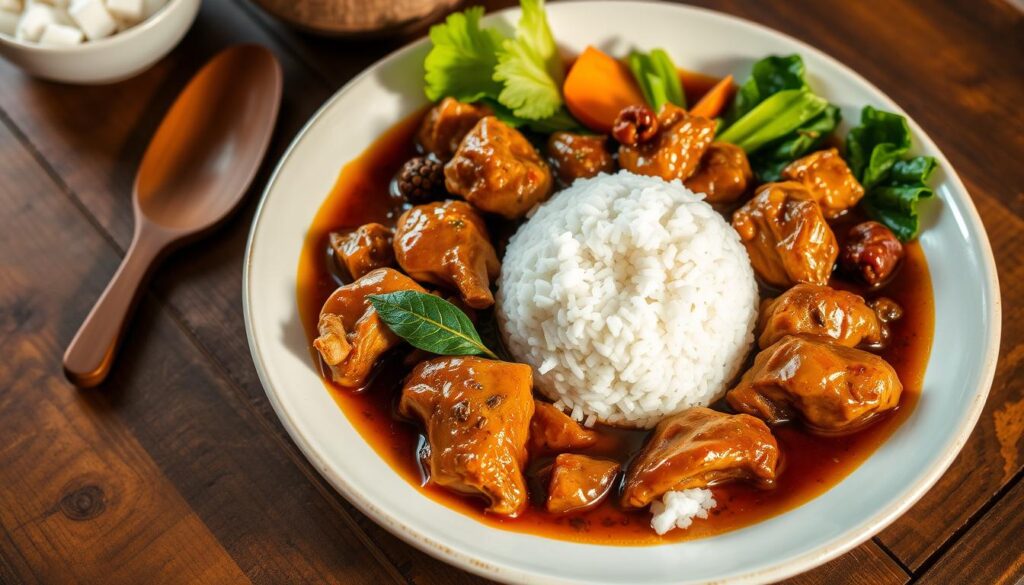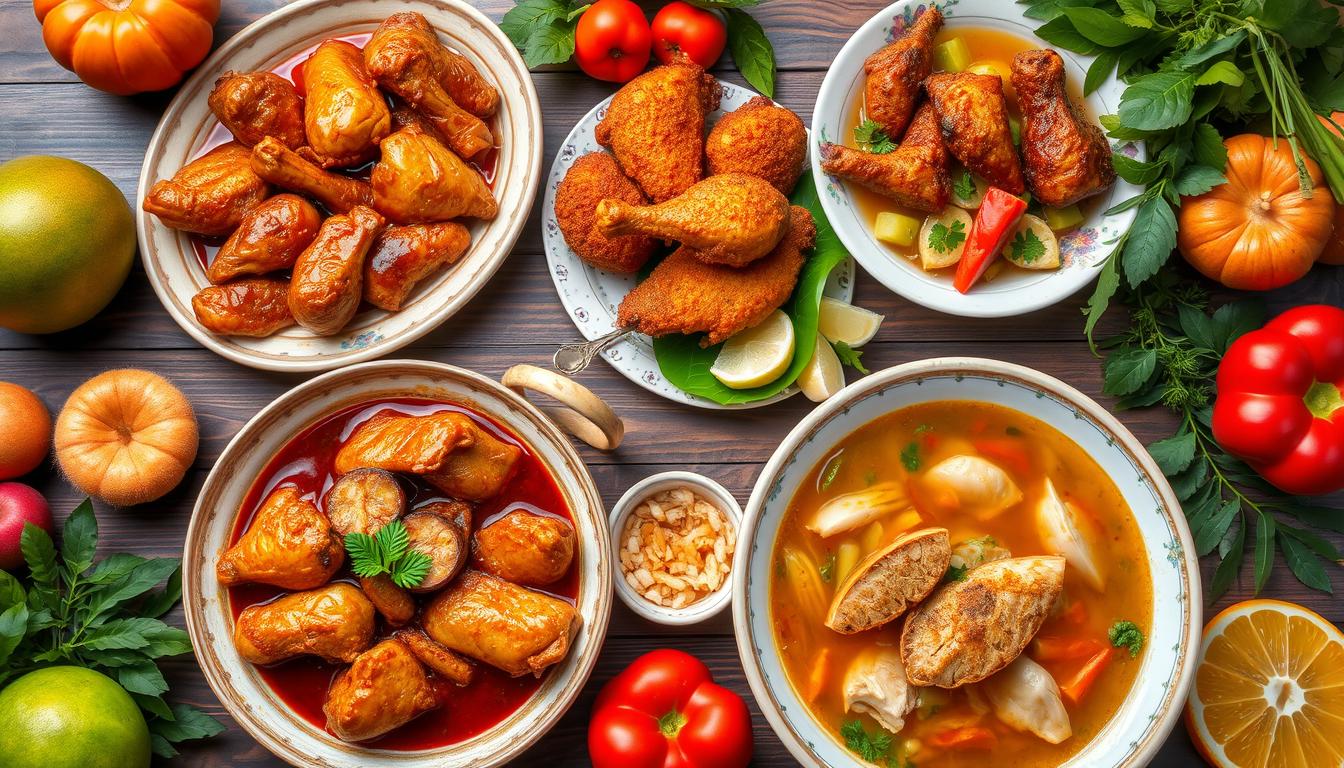Growing up in a Filipino household, the smell of cooking chicken filled the air. It was like a welcome sign to dinner. The mix of tangy, sweet, and savory flavors in these dishes was amazing. It took me back to the lively markets and family gatherings of the Philippines.
Now, I’m excited to share the rich heritage and true flavors of Filipino chicken dishes with you. It’s a journey I’m eager to start.
Want to broaden your horizons with Chicken Recipe Filipino food? Start now!
Table of Contents
Key Takeaways
- Discover the essential ingredients and cooking techniques that define authentic Filipino chicken recipes.
- Explore popular dishes like Chicken Adobo, Chicken Caldereta, and Chicken Inasal, each with its unique flavor profile.
- Learn how to incorporate traditional herbs, spices, and vegetables to achieve the perfect balance of taste in your Filipino chicken creations.
- Uncover the secrets behind the Philippines’ beloved national dish, Chicken Adobo, and master the art of simmering and marinating.
- Dive into the world of Chicken Sinigang, a tangy and nutritious soup that showcases the versatility of this humble ingredient.
Introduction to Chicken Recipe Filipino food
Chicken is a big deal in Filipino food, showing up in many favorite dishes. From the famous adobo to the special inasal from different places, these recipes show how versatile and tasty Filipino cooking can be.
The Role of Chicken in Filipino Cuisine
Every Filipino family has a special chicken adobo recipe that’s been passed down for years. This dish, made with chicken cooked in vinegar and soy sauce, is a big part of Filipino culture. It’s known for its salty, tangy taste and is easy to make, making it a favorite in many homes.
Popular Chicken Recipes in the Philippines
- Chicken Adobo: The national dish of the Philippines, known for its savory-sour flavor profile.
- Pinoy Chicken Tinola: A ginger-based soup that showcases the versatility of chicken in Filipino cuisine.
- Chicken Inasal: A grilled chicken dish originating from the Visayas region, known for its unique marinade and basting sauce.
These famous Filipino chicken dishes are not just tasty. They also show the variety of Filipino cooking, from the tangy adobo to the spicy tinola and the smoky inasal.
“Chicken adobo represents Filipino cuisine at its most accessible to the non-Filipino palate.”
These filipino chicken dishes are loved for everyday meals and big celebrations. They bring people together, creating memories and strong bonds.
Key Ingredients for a Filipino Chicken Recipe
Creating authentic Filipino chicken dishes starts with the right ingredients. These ingredients bring traditional flavors to life. From herbs and spices to fresh vegetables, each part is key to the unique taste of Filipino cuisine.
Common Herbs and Spices
The heart of Filipino chicken recipes is the spices and herbs. They add depth and complexity. Essential ingredients include:
- Garlic: A staple in Filipino cooking, garlic adds a savory, nutty flavor to the dishes.
- Ginger: Fresh ginger imparts a warm, slightly spicy essence, complementing the chicken beautifully.
- Bay leaves: These fragrant leaves contribute a subtle, earthy note to simmered dishes.
- Peppercorns: Filipino recipes often call for the use of whole peppercorns, providing a gentle heat and aroma.
- Soy sauce: A key ingredient, soy sauce adds a rich, umami character to the dishes.
- Vinegar: White or cane vinegar is commonly used to add a tangy, slightly sour element.
Essential Vegetables
Fresh, vibrant vegetables are a big part of Filipino chicken recipes. They add flavor and texture. Some common vegetables include:
- Potatoes: Potatoes add substance and heartiness to stews and braised dishes.
- Bell peppers: Colorful bell peppers lend a sweet, mild flavor and crunchy texture.
- Tomatoes: Juicy tomatoes contribute acidity and contribute to the overall balance of the dish.
Choosing the Right Chicken
For authentic Filipino chicken recipes, the chicken cut matters. Bone-in chicken thighs or legs are preferred. They keep more flavor and moisture during cooking. The skin-on chicken also adds a delightful crispness when fried or grilled.
By choosing the right herbs, spices, vegetables, and chicken cuts, you can make traditional Filipino chicken dishes at home.
Traditional Cooking Methods in Filipino Cuisine
Filipino cuisine is known for its rich and varied cooking methods. Each technique adds unique textures and tastes to dishes. From simmering Adobo to stir-frying Pancit, these methods highlight the depth and adaptability of Filipino cooking.
Simmering Techniques
Simmering, or “pagpupukpok,” is key in Filipino cooking. It uses gentle heat to blend flavors and tenderize ingredients. Dishes like Adobo and Tinola chicken soup show how simmering keeps chicken juicy and flavors balanced.
Grilling and Roasting
Grilling, or “ihaw,” is a beloved part of Filipino cuisine. It gives meats like Inasal a smoky flavor. Roasting, or “hurno,” is used for dishes like Lechon Manok, making the chicken’s skin crispy.
Stir-Frying Approaches
Stir-frying, or “ginisa,” is fast and essential in Filipino cooking. It combines chicken, veggies, and noodles in a wok. This method ensures a perfect mix of crunch and tenderness.
Marinating chicken is common in Filipino cooking. It tenderizes the meat and adds a mix of spices and aromatics. These traditional methods have shaped the flavors of Filipino chicken dishes for generations.
Step-by-Step Guide to Cooking Adobo
Learn how to make authentic Filipino chicken adobo at home. This dish is tender chicken cooked in a flavorful marinade. It’s a mix of tangy, sweet, and savory flavors.
Marinating the Chicken
Start by marinating the chicken in soy sauce, vinegar, garlic, and peppercorns. This step adds the real adobo flavor. Let the chicken marinate for at least 30 minutes. For even better flavor, marinate it overnight in the fridge.
Cooking Process and Tips
- In a large skillet or Dutch oven, brown the chicken pieces over medium-high heat. Do this for 3-4 minutes on each side to get a nice sear.
- Put the marinade and a few bay leaves over the chicken. Simmer it, then lower the heat to low.
- Let the chicken simmer for about 1 hour. Flip it every 20 minutes until it’s tender and the sauce is thick.
- Season to taste. Add more soy sauce, vinegar, or brown sugar if needed.
Serving Suggestions
Serve the chicken adobo over steamed white rice. Add chopped green onions or cilantro on top. The sauce is the main attraction, so don’t be shy with it. For a fuller meal, add steamed veggies or a green salad.

By following these steps, you can make a delicious Filipino chicken adobo at home. It’s a dish that will impress everyone with its authentic taste.
Exploring Chicken Sinigang
Chicken sinigang is a favorite in Filipino cuisine. It’s a sour and savory soup with vibrant island flavors. The tamarind-based chicken soup is known for its tangy broth and hearty ingredients, making it a comforting meal.
What Makes Sinigang Unique
The secret to sinigang’s unique taste is tamarind, a sour fruit. The broth is made by simmering chicken in water with tamarind. This creates a complex and balanced flavor.
Sinigang is different from other Filipino soups because of its sourness. It also has a harmonious blend of ingredients.
Ingredients Overview
Sinigang includes chicken and various vegetables for texture and flavor. Tomatoes, radish, and green vegetables like kangkong (water spinach) are common. It may also have other proteins like pork or seafood.
The chicken version, known as sinigang na manok, is a classic favorite.
Cooking Instructions
To make chicken sinigang, simmer the chicken in a tamarind broth. Add vegetables as the chicken cooks. This lets the flavors mix well.
The sourness can be adjusted with more or less tamarind. Season with fish sauce and black pepper for a balanced taste.
“Sinigang na manok is a comforting and nourishing dish that showcases the rich culinary traditions of the Philippines. The interplay of tart, savory, and herbaceous flavors makes it a true delight for the senses.”
Healthy Variations of Filipino Chicken Recipes
In the Philippines, chicken is a favorite ingredient in many dishes. You can make these recipes healthier without losing flavor. Just a few simple changes can make your meals both delicious and good for you.
Lighter Ingredients to Consider
Choose lean cuts like skinless chicken breasts for healthier recipes. This can greatly reduce fat and calories. Also, use low-sodium soy sauce or add flavor with fresh herbs and spices instead of salt.
Cooking Techniques for Healthier Options
- Grilling or baking chicken instead of frying cuts down on oils and calories.
- Add more vegetables like bell peppers, carrots, and green beans for a balanced meal.
- Switch to brown rice or quinoa for more fiber and nutrients.
With these easy changes, you can enjoy healthy filipino chicken recipes, low-fat filipino dishes, and nutritious chicken meals while staying healthy.
| Dish | Key Healthy Modifications | Nutritional Benefits |
|---|---|---|
| Chicken Menudo | Use boneless, skinless chicken breast; reduce oil; add more vegetables | Low in fat and sodium, high in protein and fiber |
| Chicken Afritada | Substitute skinless chicken thighs; use low-sodium soy sauce; increase vegetable content | Lean protein, nutrient-dense vegetables, balanced meal |
Serving Filipino Chicken Dishes
When pairing Filipino chicken recipes, like Adobo or Sinigang, choose side dishes that match their bold flavors. Traditional sides include steamed rice, garlic fried rice, or pancit (noodles). These options balance the richness of the chicken.
Best Side Dishes to Pair
- Steamed rice: A staple in Filipino cuisine, steamed rice is the perfect companion to soak up the flavorful sauces of chicken dishes.
- Garlic fried rice: Also known as sinangag, this fragrant and savory rice dish pairs beautifully with adobo or sinigang.
- Pancit: These Filipino-style noodles, such as bihon or canton, offer a textural contrast and can be customized with additional vegetables or proteins.
- Achara: Pickled papaya or other vegetables make an excellent palate-cleansing accompaniment to rich and savory chicken dishes.
Creative Plating Ideas
For presenting Filipino chicken dishes, use banana leaves as a base for a traditional look. Add fresh herbs like cilantro or scallions, and a calamansi lime wedge. These touches enhance the presentation and enjoyment of filipino side dishes with your chicken recipes.
| Ingredient | Percentage |
|---|---|
| Bone-in chicken thighs | 40% |
| Soy sauce | 20% |
| Lemon juice | 20% |
| Tomato sauce | 10% |
| Oyster sauce | 5% |
| Other ingredients (garlic, pepper, bay leaf, star anise, sugar, onions, potatoes, bell peppers) | 5% |
By carefully pairing with chicken recipes and creatively presenting filipino food, you can make the dining experience better. This showcases the rich, flavorful, and vibrant nature of Filipino cuisine.
Meal Prep Tips for Filipino Chicken Recipes
Preparing Filipino chicken dishes ahead of time can change the game. It lets you enjoy rich, flavorful meals with less effort. Recipes like Chicken Adobo taste even better the next day, as the flavors grow stronger.
Make-Ahead Strategies
Start early by marinating the chicken. Mix soy sauce, vinegar, garlic, and spices, then let it soak in the fridge for hours or overnight. This way, the prep work is done when it’s time to cook.
Another smart move is to cook big batches of Filipino chicken favorites like Chicken Sinigang or Chicken Afritada. Divide the cooked meals into portions for easy reheating later. Store them in the fridge or freezer.
Storage Solutions and Tips
- Keep cooked Filipino chicken dishes in airtight containers in the fridge for up to 3 days.
- Freeze cooked meals in freezer-safe bags or containers for up to 3 months for longer storage.
- When reheating, add a bit of water or broth to keep the sauce moist.
- Make sure the chicken is hot all the way through before serving for safety.
Using these meal prepping tips, you can easily store and reheat your favorite Filipino chicken dishes. This makes meal planning and cooking a breeze.

Exploring Regional Variations of Chicken Recipes
The Philippines is a diverse country with a rich culinary heritage. This diversity is seen in the regional variations of Filipino chicken recipes. As you explore, you’ll find how local specialties and ingredients shape each dish’s unique taste.
Regional Specialties Across the Philippines
In Iloilo, you’ll find the sweet and tangy Chicken Inasal. The Philippines also has the spicy Chicken Bicol Express with coconut. In Pampanga, the complex Chicken Sisig awaits, while Manila’s Chicken Afritada blends Spanish and Filipino flavors.
Adapting Recipes to Local Ingredients
When cooking Filipino chicken dishes at home, you can use local ingredients. For example, lemon or lime can replace calamansi fruit. Apple cider vinegar can also substitute coconut vinegar in some recipes. These substitutions help you capture the essence of regional Filipino cuisine and create your own unique dishes.
| Dish | Region | Key Ingredients | Preparation Time |
|---|---|---|---|
| Chicken Inasal | Iloilo | Chicken, calamansi, lemongrass, annatto oil | 1 hour 20 minutes |
| Chicken Bicol Express | Bicol | Chicken, coconut milk, chili peppers, ginger | 30 to 50 minutes |
| Chicken Sisig | Pampanga | Chicken, liver, calamansi, mayonnaise | Preparation time varies |
| Chicken Afritada | Manila | Chicken, tomatoes, bell peppers, potatoes | Preparation time varies |
Exploring Filipino chicken recipes reveals a world of flavors. You can try local chicken recipes philippines or adapting filipino dishes to your taste. The possibilities are endless in this vibrant culinary landscape.
Conclusion: Enjoying Filipino Flavors at Home
Filipino food is best when shared with loved ones. Host a Filipino-themed dinner party and let your friends and family try the unique dishes. Encourage everyone to try different dishes family-style to explore the diverse flavors and textures.
Inviting Friends and Family to Share
Gathering to share a meal is a cherished tradition in Filipino culture. When hosting a Filipino-inspired gathering, create a warm and welcoming atmosphere. Serve dishes family-style, so everyone can try a variety of flavors and experience the communal nature of Filipino dining.
Encourage your guests to engage with the food. They might learn how to wrap a lumpia or enjoy the sweet, sour, and salty notes in a classic adobo.
Resources for Further Exploration
If you want to learn more about Filipino cuisine, there are many resources available. Check out Filipino cookbooks, follow influential Filipino food bloggers, or take Filipino cooking classes in your area. These resources will give you a wealth of information, authentic recipes, and a chance to connect with others who love this vibrant culinary tradition.
FAQ
What are some popular Filipino chicken recipes?
Popular Filipino chicken recipes include Chicken Adobo, Chicken Caldereta, and Chicken Inasal. These dishes are known for their tangy, sweet, and savory flavors.
What are the key ingredients in Filipino chicken recipes?
Key ingredients are garlic, ginger, and bay leaves for flavor. Common veggies like potatoes, bell peppers, and tomatoes are also used. White vinegar and soy sauce are essential.
What are the traditional cooking methods used in Filipino chicken dishes?
Filipino cuisine uses simmering, grilling, and stir-frying. Simmering is great for Adobo and Tinola. Grilling adds smokiness to Inasal. Stir-frying is used in Pancit.
How do you make Chicken Adobo?
Marinate chicken in soy sauce, vinegar, garlic, and peppercorns for 30 minutes. Brown the chicken, then simmer in the marinade with bay leaves until tender. The sauce should thicken.
What makes Chicken Sinigang unique?
Chicken Sinigang is a sour soup made with tamarind. It includes tomatoes, radish, and green veggies like kangkong. You can adjust the sourness to your liking.
How can I make healthier versions of Filipino chicken dishes?
Use skinless chicken breast and reduce oil for healthier dishes. Add more veggies and choose brown rice. For Adobo, use less soy sauce and choose low-sodium options. In Sinigang, add more veggies for balance.
What are some traditional side dishes and serving suggestions for Filipino chicken recipes?
Serve with steamed rice, garlic fried rice, or pancit. Achara (pickled papaya) goes well with Adobo. Use banana leaves for a traditional touch and garnish with fresh herbs or a calamansi lime wedge.
How can I meal prep and store Filipino chicken dishes?
Many dishes, like Adobo, taste better the next day. Prepare marinades ahead and store them in the fridge. Cook in batches and portion for easy reheating. Store in airtight containers in the fridge for 3 days or freeze for longer.
How do regional variations affect Filipino chicken recipes?
Recipes vary by region. Iloilo is known for Chicken Inasal, while Bicol has spicy coconut-based dishes. Pampanga is famous for complex flavors. Use local ingredients like lemon or apple cider vinegar as substitutes.

